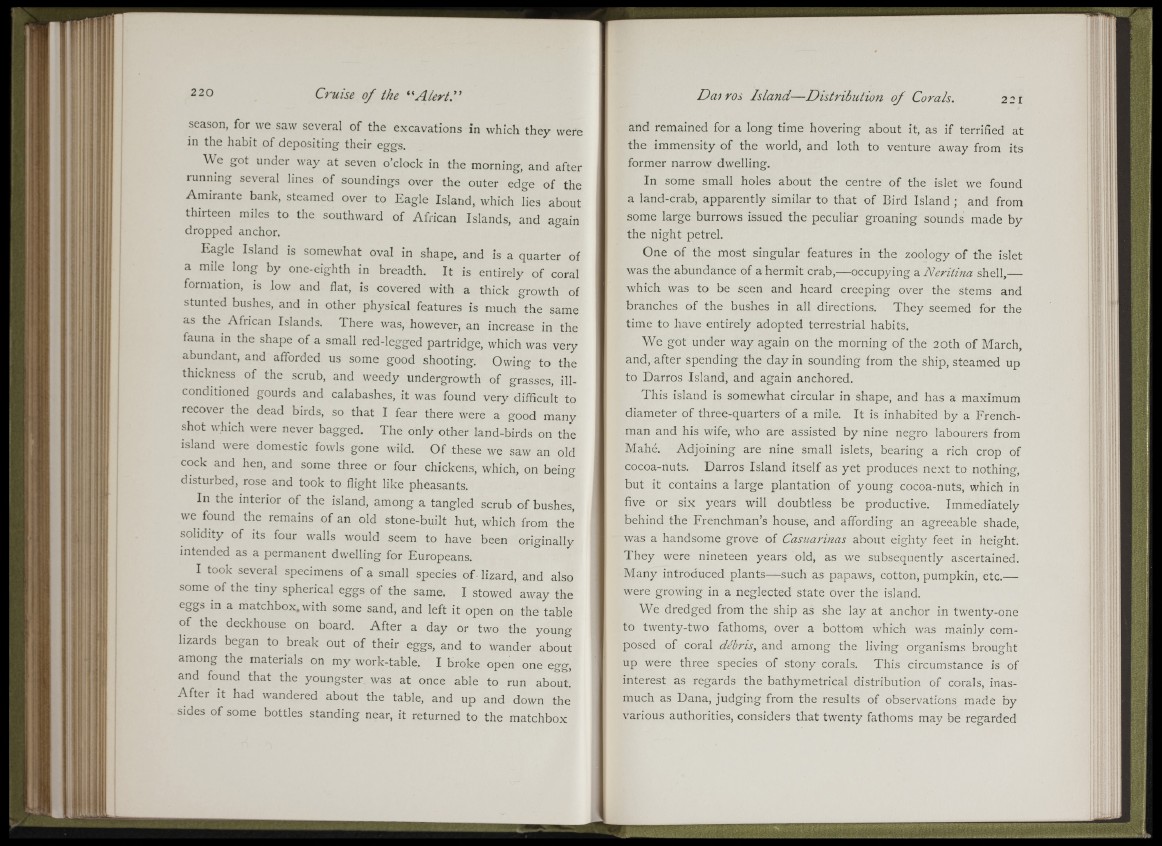
'■iU V
HI
IT
season, for we saw several of the excavations in which they were
in the habit of depositing their eggs.
We got under way at seven o’clock in the morning, and after
runnmg several lines of soundings over the outer edge of the
Amirante bank, steamed over to Eagle Island, which lies about
thirteen miles to the southward of African Islands, and again
dropped anchor.
Eagle Island is somewhat oval in shape, and is a quarter of
a mile long by onc-cighth in breadth. It is entirely of coral
formation, is low and flat, is covered with a thick growth of
stunted bushes, and in other physical features is much the same
as the African Islands. There was, however, an increase in the
fauna in the shape of a small red-legged partridge, which was very
abundant, and afforded us some good shooting. Owing to the
thickness of the scrub, and weedy undergrowth of grasses, ill-
conditioned gourds and calabashes, it was found very difficult to
recover the dead birds, so that I fear there were a good many
shot which were never bagged. The only other land-birds on the
island were domestic fowls gone wild. Of these we saw an old
cock and hen, and some three or four chickens, which, on being
disturbed, rose and took to flight like pheasants.
In the interior of the island, among a tangled scrub of bushes,
we^ found the remains of an old stone-built hut, which from the
solidity of Its four walls would seem to have been originally
intended as a permanent dwelling for Europeans.
I took several specimens of a small species of lizard, and also
some of the tiny spherical eggs of the same. I stowed away the
eggs in a matchbox, with some sand, and left it open on the table
of the deckhouse on board. After a day or two the young
lizards began to break out of their eggs, and to wander about
among the materials on my work-table. I broke open one egg,
and found that the youngster was at once able to run about
After it had wandered about the table, and up and down the
sides of some bottles standing near, it returned to the matchbox
and remained for a long time hovering about it, as if terrified at
the immensity of the world, and loth to venture away from its
former narrow dwelling.
In some small holes about the centre of the islet we found
a land-crab, apparently similar to that of Bird Island ; and from
some large burrows issued the peculiar groaning sounds made by
the night petrel.
One of the most singular features in the zoology of the islet
was the abundance of a hermit crab,— occupying a Neritina shell,—
which was to be seen and heard creeping over the stems and
branches of the bushes in all directions. They seemed for the
time to have entirely adopted terrestrial habits.
We got under way again on the morning of the 20th of March,
and, after spending the day in sounding from the ship, steamed up
to Darros Island, and again anchored.
This island is somewhat circular in shape, and has a maximum
diameter of three-quarters of a mile. It is inhabited by a Frenchman
and his wife, who are assisted by nine negro labourers from
Mahe. Adjoining are nine small islets, bearing a rich crop of
cocoa-nuts. Darros Island itself as yet produces next to nothing,
but it contains a large plantation of young cocoa-nuts, which in
five or six years will doubtless be productive. Immediately
behind the Frenchman’s house, and affording an agreeable shade,
was a handsome grove of Casuarinas about eighty feet in height.
Ih e y were nineteen years old, as we subsequently ascertained.
Many introduced plants— such as papaws, cotton, pumpkin, etc.—
were growing in a neglected state over the island.
We dredged from the ship as she lay at anchor in twenty-one
to twenty-two fathoms, over a bottom which was m.ainly composed
of coral débris, and among the living organisms brought
up were three species of stony corals. This circumstance is of
interest as regards the bathymetrical distribution of corals, inasmuch
as Dana, judging from the results of observations made by
various authorities, considers that twenty fathoms may be regarded